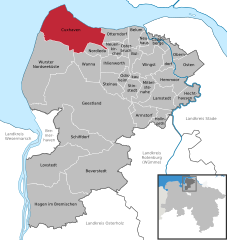Cuxhaven
Its town quarters Duhnen, Döse and Sahlenburg are especially popular vacation spots on the North Sea and home to about 52,000 residents.
Cuxhaven is home to an important fisherman's wharf and ship registration point for Hamburg as well as the Kiel Canal until 2008.
Connected directly to Hamburg by a dedicated railway line and station, it served as the major departure point for German and European emigrants until 1969 when ocean liner travel ceased.
The ornate assembly hall and associated buildings survived wartime damage and peacetime urban renewal to be restored in 1998 for use as a museum and cruise ship terminal.
[5] During the Second World War, the town hosted a base of a Wehrmacht radio network, codenamed BROWN, which transmitted data regarding experimental weapon developments, including rocketry.
Since 1964 Cuxhaven has been a state-recognized climate seaside resort (Seeheilbad) and centre of the so-called holiday region of Cuxland.
Due to its organ by Arp Schnitger and its lavish baroque interior, the building is one of the most notable of its kind in all Lower Saxony.
The high-test peroxide (HTP) submarine U1407 was raised from where she had been scuttled in Cuxhaven after WWII and rebuilt by the British, being commissioned as HMS Meteorite.








